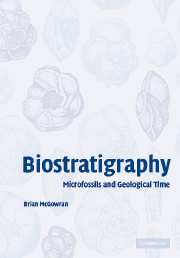Book contents
- Frontmatter
- Contents
- Preface
- Acknowledgments
- 1 Biogeohistory and the development of classical biostratigraphy
- 2 The biostratigraphy of fossil microplankton
- 3 Biostratigraphy: its integration into modern geochronology
- 4 Biostratigraphy and biohistorical theory I: evolution and correlation
- 5 Systemic stratigraphy: beyond classical biostratigraphy
- 6 Biostratigraphy and biohistorical theory II: carving Nature at the joints
- 7 Biostratigraphy and chronostratigraphic classification
- 8 On biostratigraphy and biogeohistory
- References
- Index
1 - Biogeohistory and the development of classical biostratigraphy
Published online by Cambridge University Press: 02 December 2009
- Frontmatter
- Contents
- Preface
- Acknowledgments
- 1 Biogeohistory and the development of classical biostratigraphy
- 2 The biostratigraphy of fossil microplankton
- 3 Biostratigraphy: its integration into modern geochronology
- 4 Biostratigraphy and biohistorical theory I: evolution and correlation
- 5 Systemic stratigraphy: beyond classical biostratigraphy
- 6 Biostratigraphy and biohistorical theory II: carving Nature at the joints
- 7 Biostratigraphy and chronostratigraphic classification
- 8 On biostratigraphy and biogeohistory
- References
- Index
Summary
Summary
The science of geology emerged from eighteenth-century tensions between the notion of Earth-as-machine and the notion of a recoverable Earth history. Fossils had a central role in identifying formations for mapping, in building and testing a succession of life, in reconstructing ancient environments, and most of all in developing the perception that similarity among assemblages of fossils indicates similarity in geological age. There followed the ecological facies concept and the chronological zone concept, both pre-evolutionary. This chapter takes these themes up to the mid twentieth century when the stratigraphic Guide was in preparation and planktonic microfossils were about to dominate the biostratigraphy of the Cenozoic Erathem.
Introduction
Fossils record the fleeting tenure of species as members of the Earthly biosphere. This nagging fact made more sense of the rock relationships in the exposed parts of the Earth's crust, extracting more order from an apparently chaotic jumble, than did any other observation or speculation on rocks, or any exploration and development of mineral resources. The presence of fossils in sedimentary strata could reveal a succession of ancient faunas and floras. Simultaneously, the same observations could be used to define and recognize groups of strata: thus we have both biohistory and geohistory. Sedimentary strata containing trilobites seemed to occur above strata lacking fossils (themselves sitting on the deformed crystallines), and below other strata containing ammonites.
Information
- Type
- Chapter
- Information
- BiostratigraphyMicrofossils and Geological Time, pp. 1 - 18Publisher: Cambridge University PressPrint publication year: 2005
